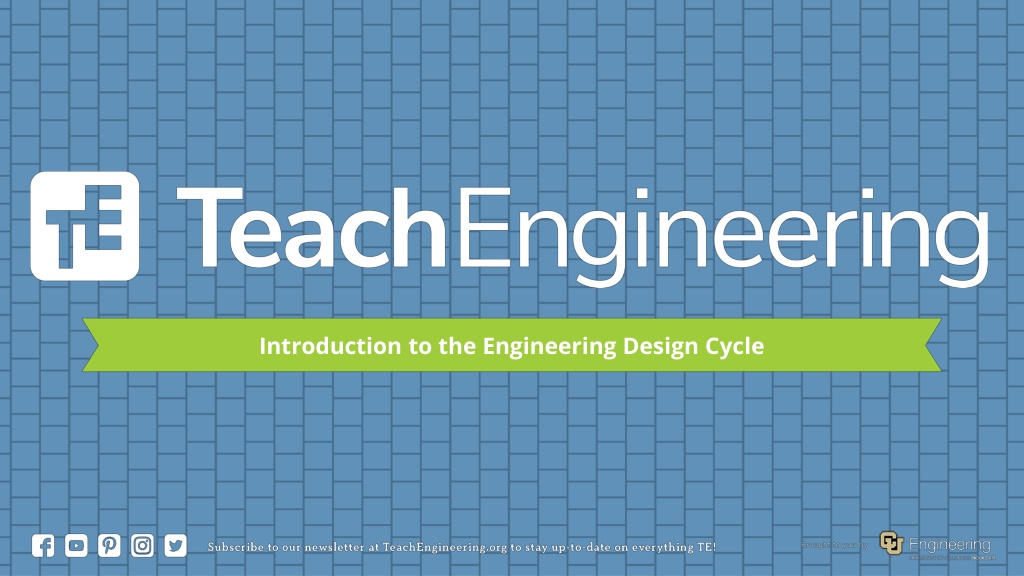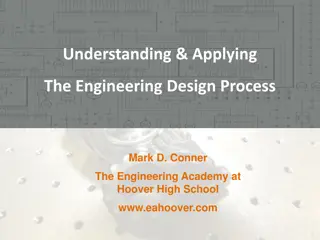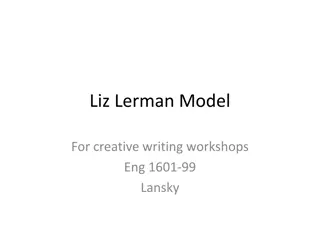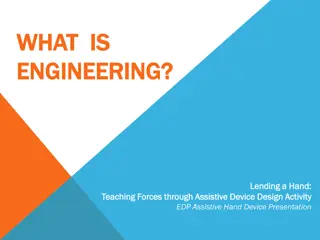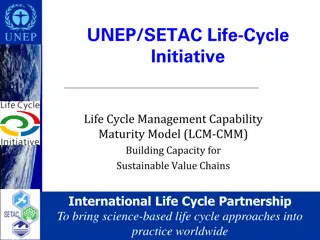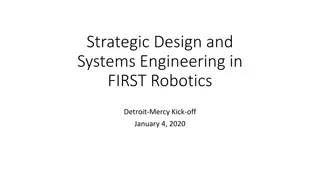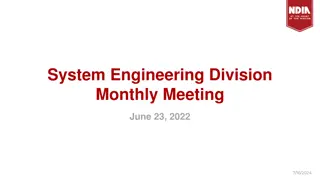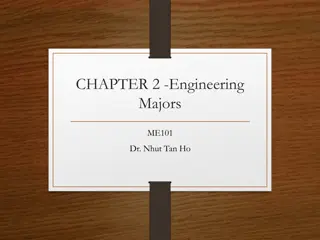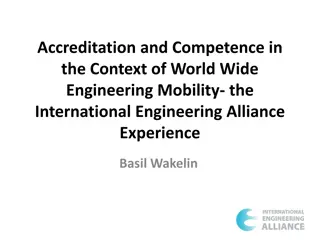Engineering Design Cycle: From Asking to Creating
Engineers follow a systematic process - the Engineering Design Cycle - to define and solve problems. Beginning with asking critical questions and identifying needs and constraints, they move on to research, imagine, plan, create, test, and improve their solutions. This process ensures that engineering projects are methodically executed to meet project requirements and constraints. An example involving students designing a desk organizer illustrates how each step contributes to the overall design process.
Download Presentation

Please find below an Image/Link to download the presentation.
The content on the website is provided AS IS for your information and personal use only. It may not be sold, licensed, or shared on other websites without obtaining consent from the author. Download presentation by click this link. If you encounter any issues during the download, it is possible that the publisher has removed the file from their server.
E N D
Presentation Transcript
What is the engineering design process? A series of steps engineers work through in order to define and solve problems! Ask Research Imagine Plan Create Test Improve 1. 2. 3. 4. 5. 6. 7.
How it all fits together
Ask: Identify the Need & Constraints Engineers ask critical questions about what they want to create, whether it be a skyscraper, amusement park ride, bicycle or smartphone. These questions include: What is the problem to solve? What do we want to design? Who is it for? What do we want to accomplish? What are the project requirements? What are the limitations? What is our goal? Criteria and Constraints Criteria are the requirements the solution must meet, such as what it must do. Constraints are the limitations on the solution, such as a maximum size or budget.
Example: Ask Students in Mrs. Anderson s English class are frustrated because they never get their work handed back to them. They can see their grades online, but without getting their work back, they don t know how to improve! By noticing that their work is not being handed back, Mrs. Anderson s students have identified a problem. One way to define this problem is by talking to Mrs. Anderson. When the students ask her why they aren t getting their work handed back, she apologizes and says that she has trouble keeping her desk organized, and sometimes misplaces assignments after they are graded. By learning that organization is the reason they are not getting their work handed back, the students have defined the problem. 1. Identified criteria: Must hold 700 papers (100 x seven classes) Must take up less than 16 x 12 inches surface area Must be moveable 2. Identified constraints: Must cost less than $5
Research the Problem This includes talking to people from many different backgrounds and specialties to assist with researching what products or solutions already exist, or what technologies might be adaptable to your needs.
Example: Research To find what aspects would make the best desk organizer for Mrs. Anderson, they ask her as well as other teachers what they would like to see in a desk organizer. They research and find key elements that they can incorporate into their design. By researching, they get to know about what already exists, and if they want that in their design.
Imagine: Develop Possible Solutions You work with a team to brainstorm ideas and develop as many solutions as possible. This is the time to encourage wild ideas and defer judgment! Build on the ideas of others! Stay focused on topic, and have one conversation at a time! Engineers develop ideas by thinking of possible solutions to the problem. Engineers evaluate ideas by considering the pros and cons of the possible solutions. Remember: good design is all about teamwork!
Example: Imagine What possible solutions can you come up with to Mrs. Anderson s problem? Mrs. Anderson s students talked to each other and came up with a few different ideas, including a stack of baskets or drawers, and a box to organize file folders.
Plan: Select a Promising Solution For many teams this is the hardest step! Revisit the needs, constraints and research from the earlier steps, compare your best ideas, select one solution and make a plan to move forward with it.
Example: Plan Building a stack of shelves or baskets is too expensive. The students realized this when they began looking at material prices. Since it would cost more than $5, this solution did not meet the constraints. Students realized that they could afford to build a file folder organizer, that it would be easy to move, and would not take up much room on Mrs. Anderson s desk. Based on their evaluation of their ideas, the students realized that the file folder organizer was a good solution to the problem.
Create: Build a Prototype Building a prototype makes your ideas real! These early versions of the design solution help your team verify whether the design meets the original challenge objectives. Push yourself for creativity, imagination and excellence in design.
Example: Create After researching and planning, the students made their first prototype of the file organizer. They made their first prototype out of a wooden box.
Test and Evaluate Prototype Does it work? Does it solve the need? Communicate the results and get feedback. Analyze and talk about what works, what doesn't and what could be improved. Engineers test solutions by trying them out to see how well they work.
Example: Test Using materials and tools given to them by the school s woodshop teacher, the students designed a small box to hold Mrs. Anderson s file folders. They gave it to her to try it out and see what she thought. The first draft is a plain wooden box designed to hold file folders upright. It is very wide and the sides are short; when Mrs. Anderson puts the files in, they flop over.
Improve: Redesign as Needed Discuss how you could improve your solution. Make revisions. Draw new designs. Iterate your design to make your product the best it can be. And now, REPEAT! ** Engineers optimize solutions by paying attention to the details of their tests, and thinking of ways the design could be better.
Example: Improve With feedback from Mrs. Anderson, the students realize that they need to redesign the box so that it holds file folders better. They made some changes: The revised design has a raised back to support the height of the files and papers The students also added a board across the center to help Mrs. Anderson organize her files.
Some famous people who used the engineering design process
Katherine Johnson Katherine Johnson was sometimes called a human computer because she performed complex mathematical calculations for NASA to help people explore space! You might have seen her featured in the movie, Hidden Figures. She is responsible for identifying and working within mathematical and technological constraints. Her math was so accurate that John Glenn refused to launch until the computer s calculations had been tested against Johnson s math.
Lee Anne Walters and Marc Edwards When the city of Flint, MI, changed its water source, big problems began. The city identified the problem when it detected fecal coliform bacterium in the water. Lee Ann Walters, a local mother, also identified high levels of lead in her water. She noticed a problem when her twins broke out with red bumps after bath time. Walters teamed up with Marc Edwards, an engineering professor and expert in lead corrosion. After testing, he reported that the water in one in six Flint homes contained twice the usual amount of lead. The city identified the criteria and constraints when they realized that finding a new water source would cost more money than they had to spend. One solution was to install water filters in 400 homes, which would ensure safe drinking water in those homes and stay within the budget constraints. But when the filters were tested, 52% of them were found to be defective. Because they won a lawsuit, the city now has the funds it needs to replace the pipes. They should be installed by 2020. Engineer Marc Edwards studied the water supply. Dirty and clean water.
James E. West Inventor James West was born in Virginia, and although he had a knack for science and engineering, his family discouraged him from attending college because finding professional work was difficult for African Americans at that time. Nevertheless, West excelled in college and after graduating took a job at Bell Laboratories. Bell Laboratories noticed that the microphones in telephones weren t sensitive enough, so they asked West to design a better microphone. One major constraint of this project was that the microphone needed to be small enough to fit into a telephone. West, along with his partner, developed the foil- electret microphone in 1964, a small microphone technology that is still used in about 90% of the microphones made today.
Jorge Odon Jorge Odon is a 59-year-old Argentinian mechanic who thought of a lifesaving invention during a dream. He identified the problem that forceps can damage babies skulls during difficult births He imagined that a vacuum-like design might be a safer alternative He tested his idea by building a prototype and gentyly suctioning his daughter s doll out of a bottle. The device is now being manufactured by a medical supply company and will be available for use all around the world. Its low cost means that people in poor countries will have access to this important medical innovation.
